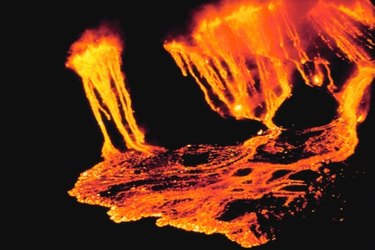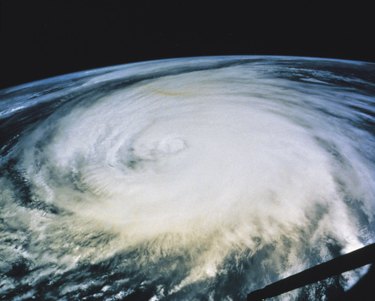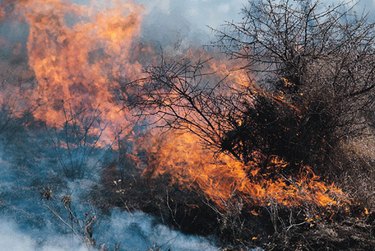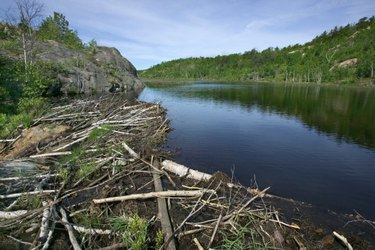
Many of the natural factors that affect the Earth's surface fall under one of the four elements. Air, fire, water and earth govern life on the planet. They tear down, reshape, destroy, recreate, modify and recycle the landscape continuously. Whether subtle rain erosion or dramatic lava flows, they all contribute to changes in the landscape. With an erupting volcano, these changes may take only moments and the surrounding landscape is transformed into a new one. Rain falling on limestone boulders will slowly dissolve the minerals, reshaping the stone into sculptures over thousands, even millions, of years. Organisms such as animals and plants also affect the earth's surface through various means.
Air
Video of the Day

Wind becomes an important weathering factor, especially when it transports particles such as sand. It can polish rocky surfaces to a smooth finish and over time and sculpt stone into impressive formations. Tornadoes instantly change any surface they touch, leaving a path of debris behind. The high winds that form hurricanes reshape the shores and land that lie in their path. By combining with water in the form of torrential rains and strong waves, they become a dramatic force of change.
Video of the Day
Fire

Fire instantly changes the landscape and can travel vast distances with the wind. In the form of a prairie or forest fire, it may reduce everything in its wake to ashes. It destroys invasive plant species and stimulates those adapted to it that will repopulate the bare areas. In the form of lava flows, new islands are created, and older ones expand and broaden their banks. Inland lava flows decimate everything in their way. They reshape the surface they bury under meters of molten lava, which cools into solid rock. If lava erupts underneath or near ice, its effects on the landscape become more dramatic accompanied with floodwater. Anything surrounding lava may also catch on fire without touching it, due to its high temperature. According to the U.S. Geological Survey, lava can have a temperature as high as 2,140 degrees Fahrenheit, depending on its composition.
Water

According to National Geographic, "Water is nature's most versatile tool." Its solid and liquid forms create impressive forces. Rain on its own weathers soil and stone, dissolving and transporting minerals. Combined with chemicals from pollution, it affects surfaces to an even greater degree. Moving rivers and oceans steadily erode their banks, creating and erasing beaches. When rivers overflow and flood surrounding areas, they dramatically change the landscape in little time. Ice that forms in crevices splits stone and glaciers scrape every surface they pass over, creating valleys and sediment deposits when they melt. Water in the form of snow crystals becomes a force of change in the form of an avalanche.
Earth

Tectonic plates shift constantly, and their collisions create mountain ranges and continents. They can also separate land and continents. The energy they release through friction causes earthquakes. Dramatic changes may result on the surface, even miles away from the actual location if other forces result from it, such as tidal waves. Ash from volcanoes and mud flows also play significant roles in changing the landscape in little time by burying it up to great depths. When combined with other elements such as water and wind, earth particles like sand and pebbles increase the process of weathering land surfaces.
Organisms

Living organisms such as plants and animals can also significantly affect the landscape. The most remarkable of these is the beaver, a species of North American rodent. It can drain specific areas of land and create ponds or lakes in others by constructing dams with trees it cuts down and mud. According to the Boreal Forest Library, "beavers are the only creatures besides humans that have such a changing effect on the landscape." Plant roots can penetrate stone crevices and eventually break even the biggest stone into smaller particles over time.